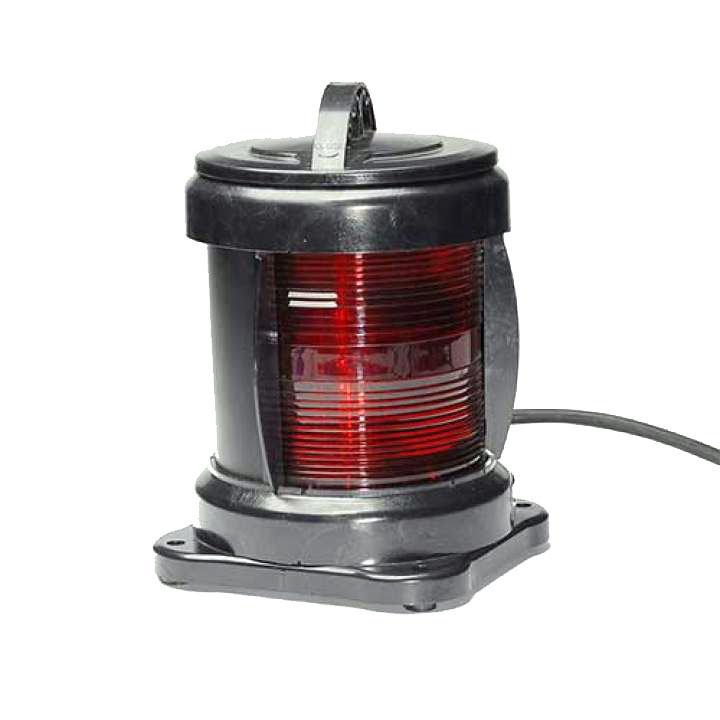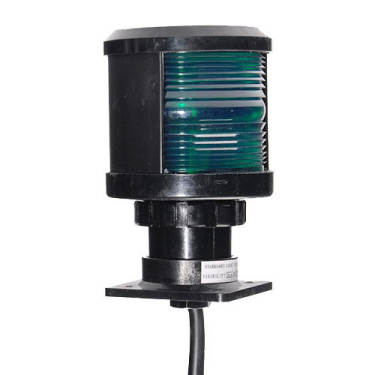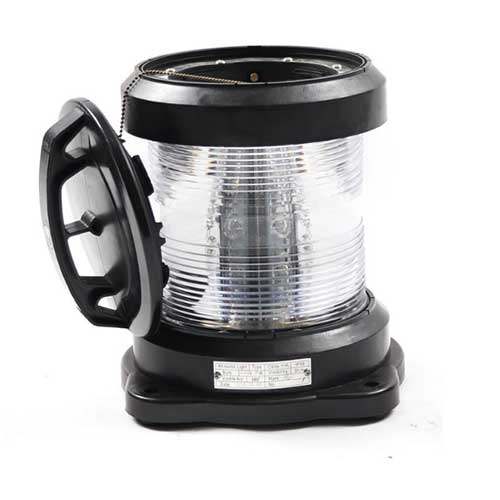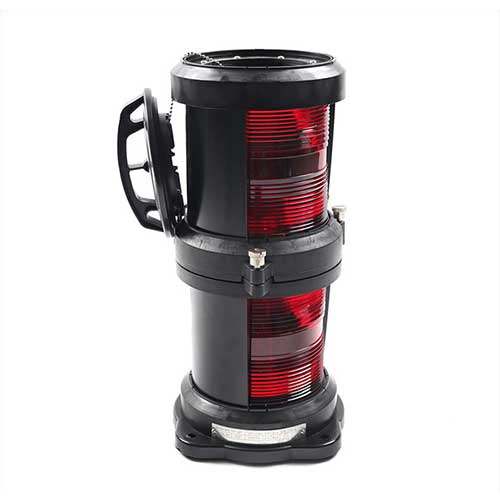Exploring the Role of Marine Navigation Lights in Safe Navigation and Preventing Collisions
Marine navigation lights are critical in guaranteeing vessel safety and averting collisions in the great expanse of the open sea. These lights act as beacons, directing ships through darkness and bad weather and assisting sailors in navigating perilous waters. This article delves into the significance of marine navigation lights, their common types, and technological advancements in navigation lighting.

What are the Definition and Purpose of Marine Navigation Lights
Definition of Marine Navigation Lights
A specialized system of lights mounted on vessels, ships, and maritime buildings to aid navigation, signal intentions, and prevent collisions at sea is referred to as marine navigation lights. These lights provide vital visual signals that allow sailors to recognize the location, size, and direction of other vessels, even in low-light conditions such as darkness, fog, or bad weather. The arrangement, color, and positioning of the navigation lights are regulated by international standards to ensure consistent and effective communication between vessels and to enhance maritime safety.

Purpose of Marine Navigation Lights
The primary purpose of marine navigation lights is to ensure safe navigation and prevent collisions among vessels in various navigational scenarios.
Collision Avoidance: Mariners can identify the type of vessel, its direction, and its status (e.g., underway, at anchor, or adrift) using navigation lights. This data enables sailors to make informed judgments in order to avoid potential collisions.
Identification: Different types of vessels have different navigation light layouts and combinations. Mariners can discern the nature and size of a vessel as well as its intended actions by viewing these lights.
Communication of Intent: Navigation lights communicate the intentions of a vessel to other mariners. A white masthead light, for example, shows that the vessel is under power and actively navigating, but a white stern light indicates that the vessel is traveling in reverse.
Vessel Positioning: The orientation of a vessel is indicated by navigation lights. Sidelights (red and green lights) indicate the port (left) and starboard (right) sides of a vessel, respectively. This information helps mariners determine the heading of approaching vessels.
Navigation in Limited Visibility: In low-visibility conditions, such as at night or in fog, navigation lights become critical for maintaining safe distances, changing course, and making navigational judgments.
Adherence to Regulations: The International Regulations for Preventing Collisions at Sea (COLREGs) specify the location and characteristics of navigation lights. By following these laws, mariners ensure consistency in the display of lights on vessels all across the world, lowering the possibility of confusion or misinterpretation.
Safety in Ports and Waterways: Port, harbor, and waterway navigation lights are also important for safe passage. They direct vessels along defined routes, aid in the avoidance of underwater hazards, and aid in the safe entry and exit of ports.

What are Common Types of Marine Navigation Lights
There are several common types of marine navigation lights, each with a specific purpose and color scheme.
1. Sidelights (Port and Starboard Lights)
Color: Red (port side) and green (starboard side)
Purpose: The ship has sidelights on both the port (left) and starboard (right) sides. They communicate the direction and heading of the vessel to other mariners. The color of the sidelight visible when approaching another vessel assists seamen in determining whether the other vessel is moving away or towards them.
2. Sternlight
Color: White
Purpose: The sternlight is located at the vessel’s back (stern). It aids in indicating the size and direction of motion of the vessel to vessels behind it. This light is especially important for vessels that are passing or trailing another vessel.
3. Masthead Light (Steaming Light)
Color: White
Purpose: The masthead light is mounted atop the vessel’s mast or tallest structure. It may be seen from all directions and indicates the presence of a vessel. This light is normally visible when the ship is in motion and under power.
4. Towing Lights
Colors: Yellow (towing light) above a white masthead light
Purpose: To advertise their status to other seafarers, vessels involved in towing other vessels or items show towing lights. The mix of yellow and white lights indicates that the vessel is towing and aids in collision avoidance.
5. All-Round Light (360-Degree Light)
Color: White
Purpose: The all-around light emits light in all directions, allowing it to be seen from any angle. It is used when a vessel is at anchor or is not under command (unable to maneuver owing to mechanical failure or other factors).
6. Anchor Lights
Color: White
Purpose: Anchor lights, which are visible when a vessel is at anchor, show the vessel’s position and help to avoid collisions. These lights are often installed above the deck and are visible from all angles.
7. Special Purpose Lights
Some vessels, such as fishing boats or pilot boats, may use customized lights that are specialized to their operations. These lights communicate information about their operations to other mariners and help prevent accidents.

8. Navigation Light Combinations
Depending on their size, purpose, and operations, different types of vessels have different combinations of navigation lights. These combinations aid seafarers in determining the type of vessel and its nautical status.
The International Regulations for Preventing Collisions at Sea (COLREGs) govern the arrangement, color, and positioning of these navigation lights to maintain uniformity and consistency in maritime navigation worldwide.

What are the Evolution Technologies for Marine Navigation Lights
Technology’s advancement has had a considerable impact on marine navigation lights, improving its efficiency, visibility, and adaptability. Technology improvements have altered navigation lights from classic incandescent bulbs to current LED systems, transforming them into more reliable and energy-efficient tools for assuring marine safety.
1. Incandescent Bulbs
The first navigation lights were made of traditional incandescent bulbs.
They emitted light when an electric current passed through a filament, producing visible light.
While effective, incandescent bulbs were less energy-efficient and had shorter lifespans compared to modern technologies.
2. LED (Light-Emitting Diode) Lights
LED technology has completely transformed marine navigation lights.
LEDs are energy-efficient, using far less electricity than incandescent bulbs yet delivering bright, concentrated light.
LED navigation lights offer longer lifespans, requiring less replacement and maintenance.
Their compact size enables for versatile placement on boats while maintaining maximum visibility.

3. Automated Systems and Sensors
Modern navigation light systems include automatic controls and sensors.
Light intensity can be adjusted by these systems based on external parameters such as ambient light, weather conditions, and vessel movement.
Automated dimming and brightening aid in energy conservation while maintaining optimal sight in a variety of settings.
4. Remote Monitoring and Control
Some navigation light systems provide remote monitoring and control features.
Through digital interfaces or software, vessel operators can remotely check the status and performance of navigation lights.
Remote control allows for swift adjustments or troubleshooting, ensuring lights are always operational.
5. Improved Durability and Reliability
Because to technological developments, navigation lights are now more durable and resistant to hostile marine situations.
Lights are protected from water intrusion, corrosion, and physical damage by improved materials and sealing procedures, extending their lifespan.

6. Compliance with Regulations
Some navigation light systems have built-in compliance functions.
These characteristics ensure that the lights comply with international norms and standards, lowering the possibility of non-compliance issues.
7. Wireless Communication
Navigation lights can communicate with other vessel systems thanks to wireless communication technology, which improves overall safety.
Integration with navigation systems allows lights to be synchronized with other navigational aids, improving coordination and reducing confusion.
8. GPS Integration
GPS (Global Positioning System) technology can be integrated into some modern navigation light systems.
This integration improves the accuracy with which appropriate navigation light combinations are displayed based on the vessel’s position and direction.
Conclusion
Marine navigation lights serve as safety signals, guiding sailors over vast oceans and canals. These marine signal lights, which range from conventional sidelights to modern LED systems, exemplify the spirit of marine navigation, allowing sailors to navigate complicated waterways and safely arrive at their destinations.


